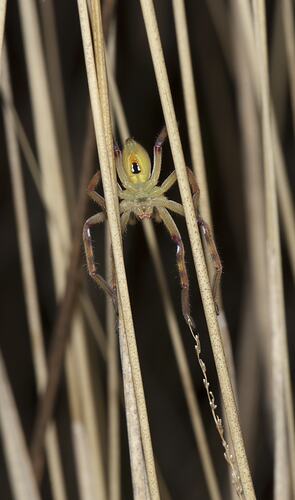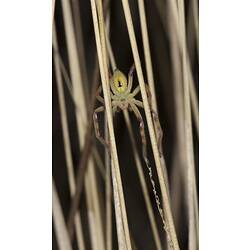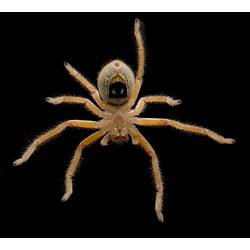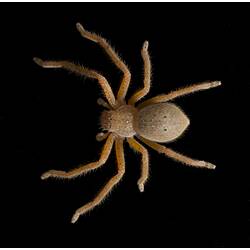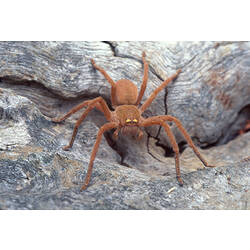General Description
Body flattened, though less so than other huntsman groups. First two pairs of legs distinctly longer than hind two pairs. Both males and females similar in colour, fawn to orange or pinkish brown. Black shield shaped marking with two white spots on underside of abdomen. Body of females to 16 mm, males to 20 mm long.
Biology
The badge huntsman is nocturnally active and occasionally comes into houses, but less frequently than other huntsman spiders. Outside it can be found hunting for prey on the trunks of trees or in foliage. During the day it will retreat beneath the bark of a tree. A silken retreat is built in a similar situation for moulting and egg laying. Some species of Neosparassus build a silken retreat in foliage by gluing several leaves together, whilst others construct shallow burrows. The egg sac, which is a flattish silken capsule, is guarded by the female. During this period she can be quite aggressive and will rear up in a defensive display if provoked. Young Neosparassus are often green in colour.
Distribution
Eastern mainland Australia and Tasmania.
Habitat
Under bark, on tree trunks and in vegetation in woodlands.
More Information
-
Animal Type
-
Animal SubType
-
Brief Id
Fawn to orange or pinkish brown. Black marking with two white spots on underside of abdomen. Does not build web.
-
Maximum Size
20 mm
-
Habitats
-
Where To Look
-
Diet
Insects
-
Hazards
No serious symptoms have been recorded from the bite of N. diana, but bites from other species of Neosparassus are known to cause general symptoms including local severe pain and swelling, sweating, nausea and vomiting.
-
Endemicity
-
Conservation Statuses
CITES: Not listed, FFG Threatened List: Not listed, EPBC Act 1999: Not listed, IUCN Red List: Not listed
-
Web
Hunter
-
Taxon Name
-
Scientific Author
(Koch, 1875)
-
Common Name
Badge Huntsman
-
Kingdom
-
Phylum
-
Subphylum
-
Class
-
Order
-
Infraorder
-
Family
-
Genus
-
Species Name
diana
